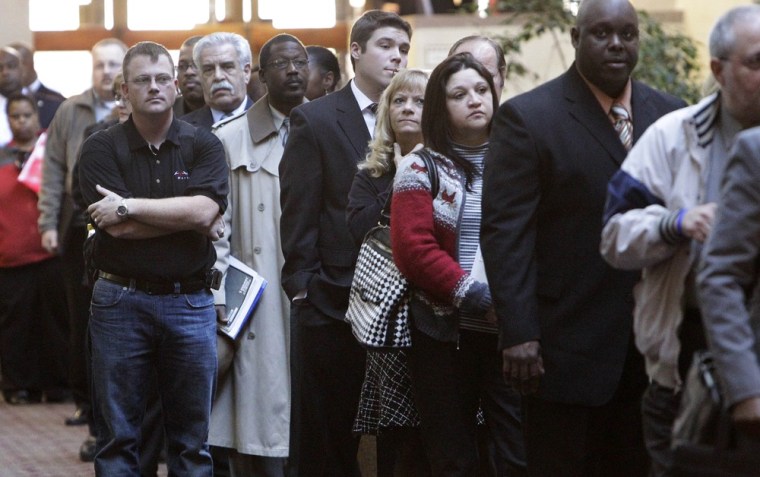New U.S. claims for unemployment benefits dropped more than expected last week, a government report showed on Thursday, pointing to continued improvement in the labor market.
Further advances in the job market are expected to be gradual, however, as American workplaces have become more efficient. Productivity rose at the fastest pace in eight years in 2010 while labor costs fell for a second straight year, something that hasn't happened in nearly five decades.
For the fourth quarter, productivity rose at an annual rate of 2.6 percent, slightly better than the 2.4 percent gain in the third quarter while labor costs fell at an annual rate of 0.6 percent after a 0.1 percent drop in the third quarter.
"The better-than-expected productivity gain and the fall in unit labor costs bode well for inflation but suggest hiring will remain muted as the economic recovery hastens," said Jeoff Hall, an economist with IFR economics.
But economists say the two-year surge in productivity may be coming to an end as companies exhaust their ability to squeeze more output out of depleted work forces. That could mean more hiring in 2011 which will help boost incomes.
The brightening prospects for jobs have helped lift consumer spending. Major retailers reported surprisingly solid January revenue gains despite snowstorms that many feared would chill spending.
Many retailers, including Costco Wholesale Corp, Victoria's Secret parent Limited Brands and teen retailer Wet Seal Inc., posted gains that beat Wall Street expectations.
The Labor Department said the number of people seeking benefits dropped by 42,000 to a seasonally adjusted 415,000 in the week ending Jan. 29. Applications had surged in the previous week after snow storms in the South disrupted work and led to temporary layoffs.
Jobless benefits applications are well below their peak of 651,000, reached in March 2009, when the economy was deep in recession. A level of fewer than 425,000 people applying for benefits is consistent with modest job growth. But applications will need to fall consistently below 375,000 to signal a likely decline in the unemployment rate.
Unemployment applications reflect the level of layoffs, but can also indicate whether companies are willing to hire.
"The drop ... is definitely a positive," Dan Greenhaus, chief economic strategist at Miller Tabak, said. While applications are still at an elevated level, "the trend has generally been lower as the bulk of the firings are now behind us."
Despite the improvement in unemployment applications, hiring has been slow to pick up. Thursday's report comes a day before the Labor Department is scheduled to issue the January employment report.
The Friday report is forecast to show that employers added a net total of 146,000 jobs. While that is a solid gain, it's barely enough to keep up with population growth. The jobless rate is expected to increase to 9.5 percent from 9.4 percent in December.
The Labor Department also said productivity, the amount of output per hour of work, rose a strong 3.6 percent in 2010 after a 3.5 percent gain in 2009, with both years the best showing since 2002. Labor costs dropped 1.5 percent last year after a 1.6 percent decline in 2009.
New orders received by U.S. factories edged up in December and shipments of finished products were stronger, signaling a continuing pickup in activity for the nation's manufacturing sector.
The Commerce Department said on Thursday that total factory orders rose 0.2 percent to a seasonally adjusted $426.8 billion -- contrary to forecasts for a 0.5 percent decline made by Wall Street economists surveyed by Reuters and following an upwardly revised 1.3 percent boost in November orders.
Healthier manufacturing activity has helped lead recovery from the recession triggered by the 2007-2009 financial crisis and shows signs that it will continue to do so.
The services sector provided good news for the economy too on Thursday. The sector grew in January at its fastest pace since August 2005, according to an industry report released Thursday.
The Institute for Supply Management said its index of national non-manufacturing activity rose to 59.4 in January from 57.1 in December. The median forecast of 68 economists surveyed by Reuters was for a reading of 57.0.
A reading below 50 indicates contraction in the sector, while a number above 50 means expansion.
The reading marked the non-manufacturing sector's 14th straight month of growth.
